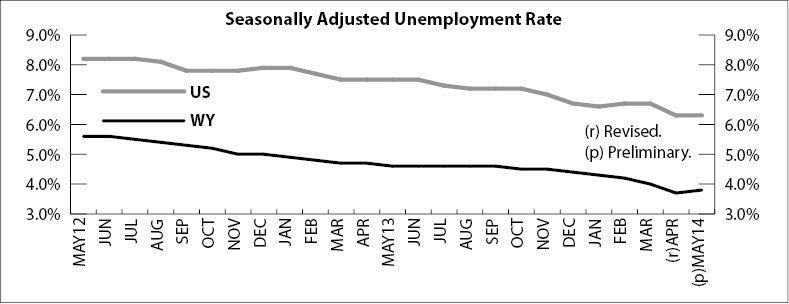
Wyoming Unemployment Rate at 3.8% in May 2014
The Research & Planning section of the Wyoming Department of Workforce Services reported that the state’s seasonally adjusted1 unemployment rate rose slightly from 3.7% in April to 3.8% in May 2014 (not a statistically significant change). Wyoming’s unemployment rate remained much lower than its May 2013 level of 4.6%, and significantly lower than the current U.S. unemployment rate of 6.3%. Seasonally adjusted employment of Wyoming residents increased, rising by 192 individuals (0.1%) from April to May.
Most county unemployment rates increased marginally from April to May. It is normal to see some fluctuations in unemployment rates and sometimes unemployment increases in May as young people leave school and join the labor force. The largest unemployment rate increases occurred in Albany (up from 2.8% to 3.4%), Laramie (up from 3.7% to 4.3%), and Sweetwater (up from 3.0% to 3.6%) counties. Unemployment fell in Teton (down from 7.0% to 5.7%), Park (down from 4.1% to 3.9%), and Lincoln (down from 5.1% to 5.0%) counties.
From May 2013 to May 2014, nearly all unemployment rates fell slightly. The largest decreases occurred in Teton (down from 6.6% to 5.7%), Campbell (down from 3.8% to 2.9%), and Sheridan (down from 4.9% to 4.1%) counties. Carbon County’s unemployment rate rose very slightly from 4.1% in May 2013 to 4.2% in May 2014.
Converse County reported the lowest unemployment rate in May (2.8%). It was followed by Sublette (2.9%), Campbell (2.9%), and Niobrara (3.1%) counties. The highest unemployment rates were found in Teton (5.7%), Lincoln (5.0%), Fremont (4.8%), and Johnson (4.8%) counties.
Total nonfarm employment (measured by place of work) rose from 291,600 in May 2013 to 293,300 in May 2014, a gain of 1,700 jobs (0.6%).
1Seasonal adjustment is a statistical procedure to remove the impact of normal regularly recurring events (such as weather, major holidays, and the opening and closing of schools) from economic time series to better understand changes in economic conditions from month to month.
